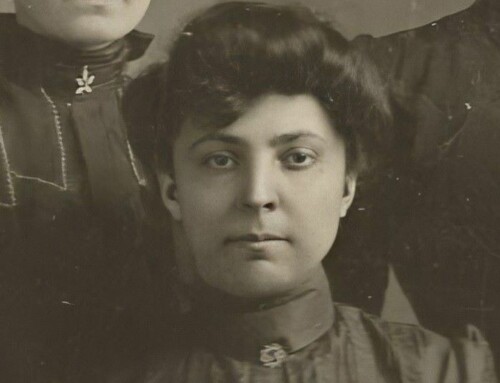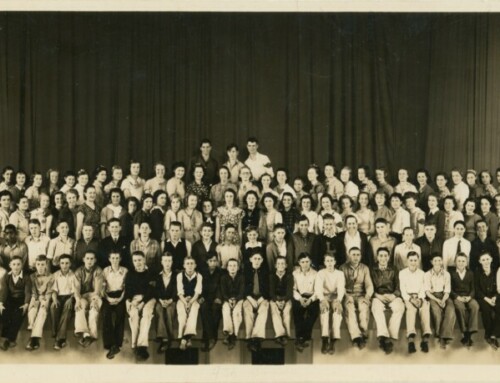“Oregon Has Today a Woman Governor” the headlines of the Daily Capital Journal (Salem, OR) trumpeted on February 27, 1909 with the subheading of “Mrs. C. B. Shelton First Woman to Govern Any State”. This amazing twist of historical fate was set in motion with the election of then-governor George E. Chamberlain to the U.S. Senate. Freshman senators were slated to be sworn in March 4th in Washington D.C. If Chamberlain stayed through the end of his term on March 1st and then traveled, he’d be sworn in late, meaning that every other member of the freshman senate class would have seniority over him. This would not do. Now ordinarily, this could have been neatly arranged by having his successor Frank W. Benson come in early as “acting governor” but Chamberlain did not intend to resign prior to confirmation of his senate seat. So on February 27th when Governor Chamberlain officially resigned and climbed aboard the train headed for the East Coast, he handed over the power of the governor’s office to his private secretary Caralyn B. Shelton. At least for the weekend, she became the first woman governor of the state of Oregon, ironically three years before women officially won the right to vote in the state.
Something important to note. At the time Mrs. Shelton became “acting governor” the state law read that in the event of the chief executive’s death the Secretary of State should become governor. It was the custom that in the absence of the governor, whether illness, travel out of state, and so forth, his private secretary should become acting head of state.
The twist of fate in this story hinged upon the fact that prior to Governor Chamberlain’s administration, private secretaries had been male.
I stumbled across this fascinating story while looking through a set of Guiss family photographs in the collection of the Willamette Heritage Center. The photographs were labeled with Guiss family names except for one, the name Caralyn Shelton. Who, I wondered, was Caralyn Shelton? I traced the Guiss family from a drug store in Woodburn to Patton Brothers Store in Salem. Leah Guiss, daughter of the drug store Guiss’ married Edwin Cooke Patton and it is because of this union that we find a connection to Caralyn. According to the 1905 Marion County census, Mrs. Shelton boarded with the Patton family. The timing of this is concurrent with her service to Governor Chamberlain in Salem.
Further digging into the U.S. Federal Census records and city directories provided a neat framework for Caralyn Shelton’s life but it was not until I accessed the Historic Oregon Newspapers Project and Historical Oregonian databases that the full story came to light. The newspapers allowed a peek into her childhood in Union County, Oregon, her work history, and eventually her unique role in the history of Oregon. Sadly with the exception of a rather grainy picture in the Oregonian dated February 13, 1909, the two photographs from the Willamette Heritage Center are the only ones I’ve been able to discover. So who was Caralyn B. Shelton, Oregon’s first woman governor?
Carrie B. Skiff was born in the month of October, 1876 to Willis S. & Mary C. Skiff of Union County, Oregon. Her father made history himself in Union County when he mysteriously disappeared on the night of July 24, 1886 while waiting for a midnight train to take him home. Because of Skiff’s prominence in the community, the Pinkerton detective agency was called in and huge sums were spent in tracing down every clue, but to no avail. Carrie’s mother died two years later leaving her orphaned children, Nolan, Carrie, and Mabel, in the care of their older brother Orrin and his wife Elizabeth. This was not a happy situation and a year later local attorney J. W. Shelton was appointed guardian for the trio.
On October 27, 1892 at the age of 16, Carrie married John W. Shelton across the border in Weiser, Idaho. Both the bride and groom were from Union, Oregon. The couple moved to Portland shortly after. Tragically, two years later and just a month before her 18th birthday Carrie would find herself a widow. After John’s death she obtained a job as a stenographer at the law firm of Starr, Thomas and Chamberlain. This was her first introduction to George E. Chamberlain, an up and coming attorney, politician and future governor of Oregon.
She began her business career working in his law office as a stenographer where it quickly became apparent that she had a natural aptitude for the more technical terms of the law. This ability led to the opportunity to draw up many of the legal papers prepared in the office, work usually entrusted to a young lawyer. In 1901, at the request of Mr. Chamberlain, she changed her first name to Caralyn to avoid confusion with Chamberlain’s daughter also named Carrie. The unusual spelling of Caralyn, with two “a”s was often standardized to the more common Carolyn in the media and public. When Mr. Chamberlain was elected District of Attorney for Multnomah County and later Governor of Oregon she went with him as his private secretary and assisted at innumerable state and social affairs in Salem including the 1903 visit of U.S. President Theodore Roosevelt.
A newspaper article from the time period described her as a “tall, slender woman, with dark eyes and hair, a woman with a charming manner, and behind it all a subtle personality.” She faithfully served under oath of office as Governor Chamberlain’s private secretary until that fateful day in Oregon history that she found herself “acting governor” for the weekend. Then Mrs. Caralyn B. Shelton packed her own bags for Washington D.C. to continue her work as Chamberlain’s private secretary in addition to clerking for the senate committees that he served on. This working partnership continued for 30 years until the death Chamberlain’s wife in 1925.
In February of 1926, George Chamberlain suffered a paralytic stroke which left him an invalid and on July 12th of the same year he married his longtime secretary Caralyn B. Shelton in Norfolk, Virginia. It came as no surprise to his friends or family. Sadly, their marriage only lasted for 2 years before he passed away from causes incident to the stroke he had suffered. After his death, Caralyn returned to her childhood home in Union, Oregon to live. She made frequent visits to friends in Portland and Salem, including the Guiss and Patton families. On February 3, 1936, Mrs. Caralyn Shelton Chamberlain passed away after a sudden illness, while in Salem. After a memorial service at Rigdon’s Chapel, her body was sent back east to be buried in Arlington National Cemetery with her husband George Chamberlain and his first wife. A fitting end for a woman who dedicated her life to public service both in her home state of Oregon and later to her country.
This article was written by Kaylyn F. Mabey for the Statesman Journal where it was printed 15 February 2015. It is reproduced here for reference purposes.
This article was updated on 28 February 2024 to reflect additional research sources uncovered during the development of an exhibit on Governor Caralyn B. Shelton. The phrase “but Benson was too sick to do this” was replaced with “but Chamberlain did not intend to resign prior to confirmation of his senate seat.” Chamberlain faced several complex issues in making his decision to withhold his resignation prior to being sworn in by the U.S. Senate. First, he was the second senator elected under the Direct Primary system but the first candidate [Democrat] from the non-governing party [Republican]. Second, the opportunity to demonstrate by action his long-standing support for women’s suffrage following the 1908 defeat of the women’s suffrage measure, for the fourth time. And finally, Secretary of State Benson’s health problems, the out-of-state treatment of which, handicapped his ability to serve in office the prior legislative term. This researcher believes that it was a shrewd and calculated decision to leave his female secretary as governor (for a weekend).
References:
- “Oregon Has Today a Woman Governor” – Daily Capital Journal (Salem, OR), February 27, 1909
- “Woman Who Was Acting Governor of Oregon” – Oregonian January 11, 1914
- 1905 Marion County Census – p. 40
- 1895 Multnomah County Census
- Portland City Directories – 1894-1902
- A.E. Eaton vs. Orin Skiff et al; default of Orin and Lizzie Skiff – The Oregon Scout (Union, OR), September 28, 1889
- U.S. Federal Census – 1880, 1900, 1920
- Idaho Marriage certificate – John W. Shelton & Carolyn Skiff
- Virginia Select Marriages 1785-1940
- District of Columbia Select Deaths and Burials 1840-1964
- U.S. National Cemetery Interment Control Forms 1928-1962
- “Widow of Late U.S. Senator Dies After Short Illness” – Oregonian February 4, 1936
- “Governor George E. Chamberlain Elected United State Senator by Good Margin on the First Ballot,” Oregon Statesman 20 Jan 1909, p. 1
- “Oregon’s New Senator – Democrat Sent to Represent a Republican State,” The Washington Herald, 28 Mar 1909, p. 29
- “Election of Senator Chamberlain, the People’s Choice,” Oregon Historical Quarterly, Vol. 53, No. 2, p 63-88








